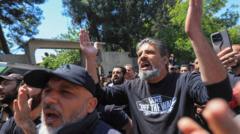The suburb of Ashrafiyat Sahnaya, near Damascus, has become a poignant symbol of the intensified fears facing the Druze community in Syria. During a violent outbreak of sectarian clashes in April, Lama al-Hassanieh huddled in her bathroom as chaos erupted outside her door, underscoring the precarious position of the Druze, who identify as followers of a faith derived from Shia Islam.
Long viewed as a minority seeking protection under the Assad regime, the Druze historically maintained a delicate alliance with the government, hoping that such loyalty would shield them from the rampant sectarian violence that has scarred Syria's landscape. Yet, with the emergence of Sunni Islamist rebels and the fraying of this unspoken pact, the Druze now face existential threats as they feel increasingly cornered and vulnerable.
April's violence was sparked by allegations against a Druze religious leader, resulting in virulent responses from extremist factions and sparking attacks in various communities across Syria. Reports indicate that these clashes resulted in over 100 deaths— a stark reminder of the climate of fear the Druze now inhabit.
Lama Zahereddine, a pharmacy student preparing for graduation, recounts harrowing experiences that illustrate the risks facing her community. Armed groups stormed university dorms, and she witnessed brutal violence directed at students based solely on their religious affiliation. Despite being close to completing her studies, she, too, recognizes the dangers that overshadow her academic journey. "How could I stay?" she asked, faced with escalating sectarian threats.
The trust in governmental structures designed to protect citizens is dwindling. Disillusioned, Lama laments her reality, saying, "What I should be able to trust has turned against me." Despite assurances from the Syrian government of their commitment to protect minority rights, many Druze remain skeptical of such claims in light of systemic failures and lack of accountability for attacks against them.
As violence ebbed after the initial outbreak, an atmosphere of wariness now pervades the community. Many Druze express concern over the rise of a Sunni-dominated political landscape that leaves little room for religious minorities like themselves. "Trust has been broken," Lama al-Hassanieh notes, highlighting the difficulty of discerning who is genuinely invested in their well-being.
As violence continues to reshape the trajectory of Syrian society, the Druze community finds itself at a crossroads, seeking both safety and a place within the national discourse as equal citizens. Their call is clear: "We don't want to be viewed as a minority. We are Syrians, and we demand to be treated as such."


















